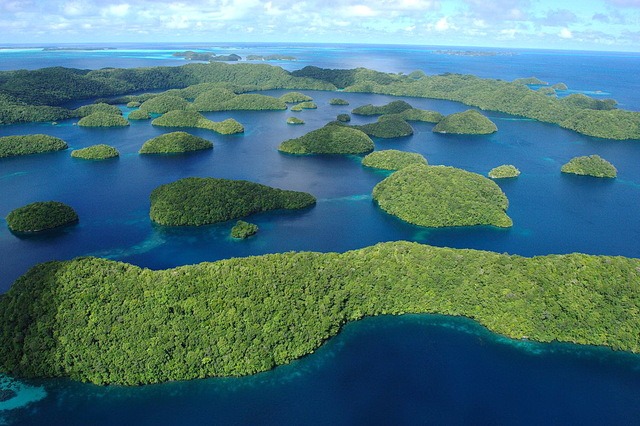Published in the Ocean Watch column, Honolulu Star-Advertiser © Susan Scott
February 11, 2017
KOROR, PALAU >> This week I’m working (so-called) in this island nation as a naturalist for an Oceanic Society snorkeling tour. I feel honored to represent this organization. Inspired by Rachael Carson’s book “Silent Spring,” San Francisco sailors and scientists founded OS in 1969 as the first nonprofit dedicated to building a healthy future for the world’s oceans.
Over the years, other caring people created dozens of ocean-centered organizations, and in 1990 OS set its sights on marine conservation through informed travel. Its mission is to help wildlife through education and inspiration.
 The nation of Palau contains 250 islands. The government designated
The nation of Palau contains 250 islands. The government designated
193,000 square miles of its territorial waters as a marine preserve in 2015.
Courtesy Luxtonnerre / Wikimedia Commons
As a former Midwesterner who was once afraid of the ocean and its inhabitants, I’m a poster child for the effectiveness of that tactic. And for novice snorkelers as well as old pros, there’s no better place to get inspired than Palau.
The tiny island nation has it all. A surrounding reef protects the waters around Palau’s stunning Rock Islands, making the inside waters calm. And because the archipelago is 500 miles north of the equator, water and air are pleasantly warm.
Thriving in this delicious water are about 400 species of hard corals and 300 species of soft. One writer describes the coral colors here as “an explosion in a paint factory.” The coral reefs support at least 1,400 species of fish and thousands of invertebrates, many still unidentified.
Palau’s 250 islands total just a bit more land area than the island of Lanai, and the country’s 21,000 residents live scattered throughout. But even though the country is small, when it comes to protecting its natural wonders, people think big. In 2009 Palau created the first shark sanctuary in the world, banning all shark fishing in its waters.
The government took another giant conservation step in 2015 by designating 193,000 square miles, about 80 percent of its territorial waters, a marine preserve. That’s an area bigger than California. The other 20 percent of Palau’s water is open to locals and a small number of commercial fisheries.
Enforcing a fishing ban in such a huge area is tough. But with the help of the Australian navy, the Pew Charitable Trusts and a nonprofit organization called SkyTruth, which tracks and reports foreign vessels via satellite, Palau’s marine patrol can nab poachers. The officers don’t get all trespassers, but Palau officials intend the 2016 arrest of 10 men aboard a Taiwanese pirate ship to be a warning: Palau means business.
Today, eight OS guests and I begin exploring Palau’s exploded paint stores and swimming with 1,400 paint chips. It’s almost embarrassing to call this work.